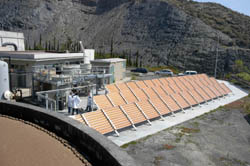Ecological approach to seawater decontamination
The contamination of water resources by hazardous materials is a serious environmental threat. Many of these substances are biorecalcitrant and thus not biodegradable via conventional methods. The Energy, Environment and Sustainable Development Programme funded the CADOX project to address this challenge. The research consortium looked to combine the benefits of ultraviolet radiation with those of the Fenton process, which relies on a mixture of hydrogen peroxide (H2O2) and iron ions (Fe2+). The so-called photo-Fenton process consists of compound parabolic collectors, which drive the photochemistry, and specific concentrations of the H2O2 and Fe2+ catalysts. In order to maximise the extent of biodegradation, an aerobic Immobilised biomass reactor (IBR) was incorporated into the system. Additional advantages of the IBR include improved nitrification and denitrification. During CADOX, the novel system was tested out on seawater artificially contaminated with methylphenylglycine, a common biorecalcitrant pollutant. The results were impressive with approximately 90% removal of the total organic carbon from the waste stream. In addition, an economic analysis indicates that the technology is competitive with respect to cost effectiveness.







